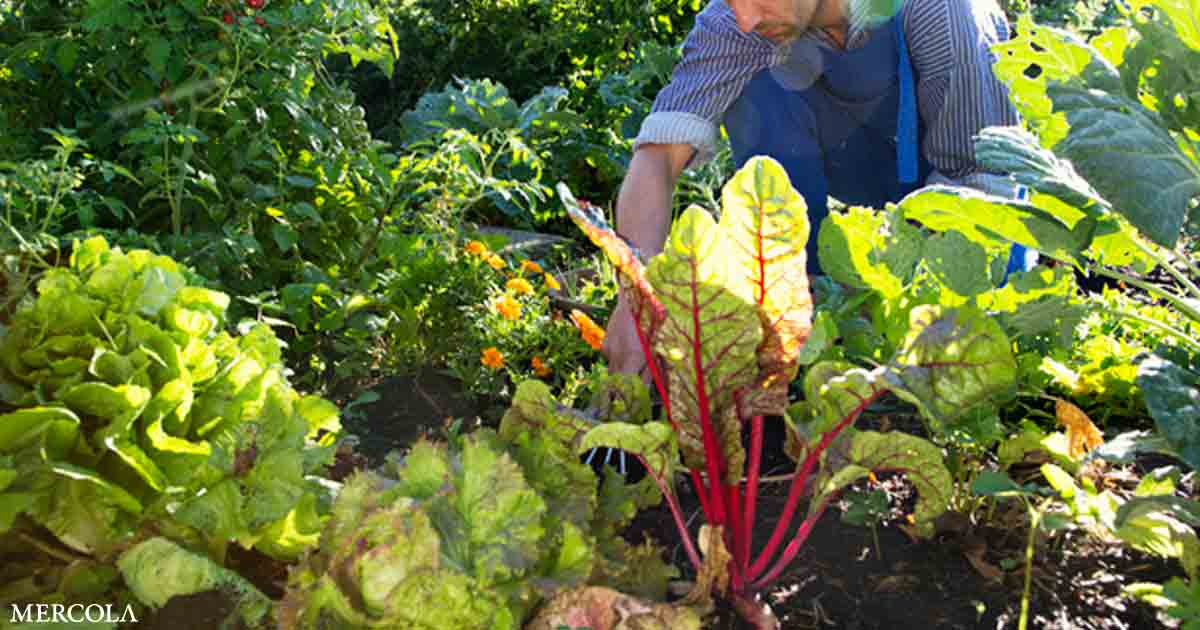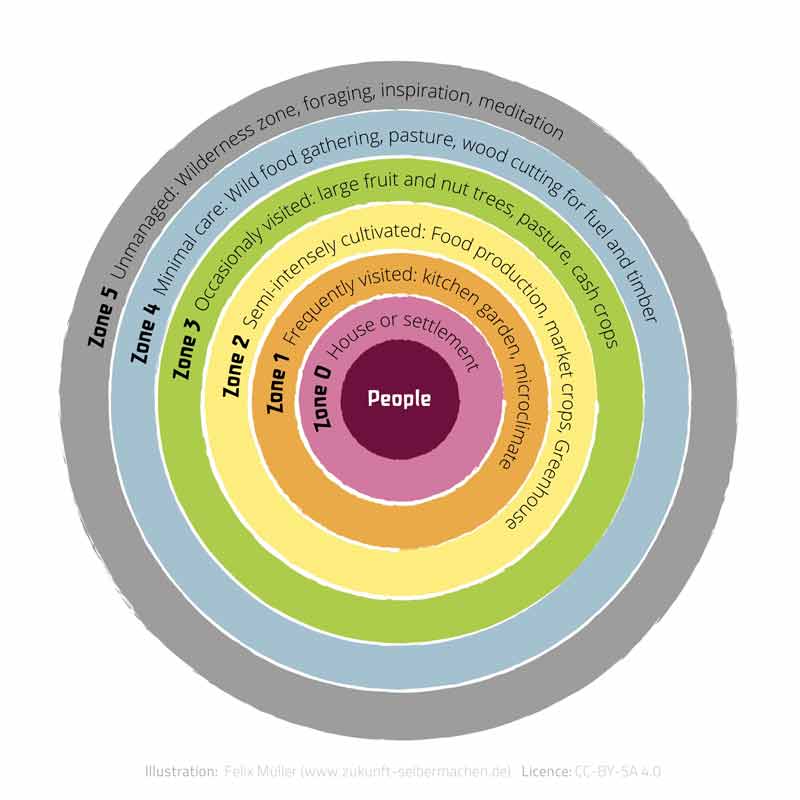
This article was previously published March 22, 2019, and has been updated with new information.
A process known as “succession” occurs when one plant species replaces another.1 As explained in the National Geographic short film featured above, when an area is left to its own devices, it will naturally turn into a forest over time, replete with a wide variety of plant species, and this diversification occurs unaided by man.
The film features a man-made “forest garden” designed to mimic this kind of naturally occurring ecosystem, where fruit and nut trees grow intermingled with shrubs, herbs, vines and a variety of perennial vegetables in a seemingly wild-grown setting. According to National Geographic:2
“U.K.-based Martin Crawford is one of the pioneers of forest gardening. Starting out with a flat field in 1994, his land has been transformed into a woodland and serves as an educational resource for others interested in forest gardening.
This short film by Thomas Regnault focuses on Crawford’s forest garden, which is abundant, diverse, edible and might be one answer to the future of food systems.”
Diversity Allows the Entire System to Thrive
In his unconventional garden, Crawford grows 500 different edible plants and trees, yet the garden only requires a few hours of maintenance per month. This low maintenance requirement is a direct result of creating a self-sustainable and renewable ecosystem where everything is working in a symbiotic and supportive fashion.
While many today think of food production as the process of planting an annual crop, this really isn’t natural, Crawford says. In a natural ecosystem, there are several layers of plant growth, starting with tall trees at the top, with shorter trees, medium and low shrubs, root crops, climbing plants and low-lying ground cover underneath.
What’s more, while many of these produce edible foods directly, other plants, referred to by Crawford as “system plants,” are there simply to help the system as a whole thrive. In this group you have nitrogen-fixing plants, mineral accumulators and plants that attract pollinators and insects that serve as natural pest control by eating other more harmful bugs.
Aside from being low-maintenance, this kind of diversification also protects your crops from all manner of bad weather, be it storms, excessive rains or droughts. While some may fail, others may benefit and do better, but in many cases, a majority of your crops will survive and do well no matter what the weather is doing, Crawford says.
This cannot be said for monocrop farming, where if conditions are poor, the entire crop will fail all at once. As such, having a diverse garden is key to food security. “It gives you maximum resilience,” Crawford says.
How to Use Regenerative Farming Principles in Your Own Garden
Over the years, I’ve interviewed several pioneers in regenerative agriculture, among them, Gabe Brown, who has a regenerative farm in Bismarck, North Dakota. As explained by Brown, to grow healthy food you have to create healthy soil.
There are five basic principles to building a healthy soil ecosystem, and most of these can be implemented even if all you have is a small garden plot in your backyard:
|
Avoid disturbing the soil microbiome with tillage, herbicides, pesticides and fungicides — The less mechanical disturbance, the better. The same applies in your home garden. The more you till, the faster the soil degrades and is destroyed, as it destroys soil aggregates and mycorrhizal fungi, which houses the microorganisms needed for nutrient transfer. Similarly, by adding synthetic nitrogen to the soil, the biology is radically altered — it starts consuming carbon in the soil aggregate, which destroys the soil structure. Without soil structure water cannot infiltrate and move throughout the soil profile and be stored via organic matter. The soil aggregates also provide the home for soil biology, which is critical to producing nutrient dense food. |
|
Protect the soil’s surface with cover crops and cover crop residue — Forest and prairie land is completely covered with vegetation and this is the environment farmers need to emulate. That vegetation protects the soil not only from wind and water erosion, but also from excessive heating and cooling. These living plants are what end up actually “growing” topsoil. In your home garden, you can use mulch, wood chips or lawn clippings to do this. You never want to leave soil bare, as bare soil will have a negative effect on soil biology and the water cycle. Cover crops and other forms of “soil armor,” such as wood chips, effectively prevent water evaporation and lowers the soil temperature. There is easily a 20-degree F difference or more between soil that is bare and soil that is covered. When air temperatures reach 90 degrees or so, soil temperatures will rise well above 100 degrees, which will dry everything out and fry the plants’ roots. “If you have good armor or residue on the soil surface, the temperature there can be in the 80-degree range. Those plants are growing. It’s a huge difference in production for the producer,” Brown says. |
|
Diversify — Having a diverse array of plant life is essential, and cover crops fulfill this requirement as well. Home gardens will also benefit from cover crops, helping to improve the soil, attract beneficial insects and capture more sunlight (energy). |
|
Maintain living roots in the ground as long as possible — In conventional farming, once a cash crop is harvested, there’s nothing left in the field to capture sunlight and keep growing. Maintaining some kind of growth at all times is key. If you have a small vegetable garden, don’t leave it bare once you’ve harvested your veggies. Instead, plant a cover crop in anticipation for the next season. To make the transition back from cover crop to your chosen vegetables the following season, avoid the temptation to till the cover crop into the soil. Instead, use one of the following methods to kill off the cover crop and prepare the plot for new crop growth:
Once the cover crop has been killed off, you’re ready to plant your vegetable seeds. For a small garden, use a hoe to part the cover crop remains over to the side. Create a small slice in the soil, drop in your seeds and cover with a small amount of soil. If you’re planting a transplant, simply move the cover crop aside, dig the hole and plant as normal. |
|
Integrate livestock and other animals, including insects — Centuries ago, large herds of bison and elk moved across the landscape, foraging, depositing manure and trampling vegetation into the ground. All of this is part of the natural cycle that is missing when animals are kept in concentrated animal feeding operations. Many have started raising chickens in their backyards again and chickens are an excellent addition to a sustainable garden. Rabbits, pigeons and ducks are other alternatives that could work in some suburban areas, but even if circumstances or local laws prevent you from adding animals, be sure to plant flowering plants that attract pollinators and predator insects, as these will naturally help ward off pests that might otherwise decimate your main crop. |
Tips to Help You Design Your Own Permaculture Garden
While Crawford refers to his garden as a “forest garden,” it’s essentially a form of permaculture garden. Permaculture epitomizes sustainability by harnessing mutually beneficial relationships to create synergistic, self-supporting ecosystems. Its principles incorporate the best of organic, biodynamic and regenerative agriculture. According to the Permaculture Institute:3
“Permaculture is an ecological design system for sustainability in all aspects of human endeavor. It teaches us how to design natural homes and abundant food production systems, regenerate degraded landscapes and ecosystems, develop ethical economies and communities and much more.”
In short, permaculture is an agricultural system in which the parts of the system are all interconnected, working with nature as opposed to against it. The word “permaculture” derives from “permanent agriculture” or “permanent culture.” The focus is not on any one element of the system but on the relationships among them — animals, plants, insects, microorganisms, water, soil and habitat — and how to use these relationships to create self-supporting ecosystems.
If you want to shoot for a forest garden like Crawford’s, take his advice and just start planting some larger trees (or incorporate ones you already have on your property), then add smaller trees, shrubs and plants as you go along. You don’t have to have it all planned out before you begin.
While there’s no set formula for designing a permaculture garden, here are a few basic guidelines to consider:4,5
- Copy a forest blueprint with a tree canopy that gives way to smaller trees, flanked by shrubs, with smaller shade plants under the canopy
- Group plants by compatible roots and canopy systems, and by soil type, such as acid lovers in one area and drought-resistant in another
- Identify microclimates in your yard and use them to your advantage, such as cooler shady corners, full sun, rocky areas and areas that receive abundant drainage
- Incorporate as much diversity as possible, focusing on native plants and animals
- Plan your area in zones based on use and accessibility; for example, plant your herb garden and greens in the areas easiest to access, such as along the driveway or along a path near your deck
Should you have a large enough piece of land, you could go a step further and take into account the five permaculture zones as illustrated in the following diagram. At its center are you and your house, but its outermost zone is untamed wilderness.
Zones are organized in a way that maximizes energy efficiency, so activities are sorted by frequency of use, tending, visits and so on. For more detailed information about these zones, check out the Permaculture Research Institute’s “Permaculture Zones Primer.”6
